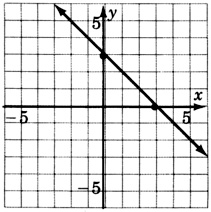7.5: The Slope-Intercept Form of a Line
( \newcommand{\kernel}{\mathrm{null}\,}\)
The General Form of a Line
We have seen that the general form of a linear equation in two variables is ax+by=c (Section 7.4). When this equation is solved for y, the resulting form is called the slope-intercept form. Let's generate this new form.
This equation is of the form
The following examples illustrate this procedure.
Solve
The equation is of the form
Solve
This equation is of the form
Solve
This equation is of the form
The Slope-Intercept Form of a Line
The Slope-Intercept Form of a Line
A linear equation in two variables written in the form
Sample Set A
The following equations are in slope-intercept form:
The following equations are not in slope-intercept form.
Practice Set A
The following equation are in slope-intercept form. In each case, specify the slope and
- Answer
-
- Answer
-
- Answer
-
- Answer
-
- Answer
-
- Answer
-
Slope and Intercept
When the equation of a line is written in slope-intercept form, two important properties of the line can be seen: the slope and the intercept. Let's look at these two properties by graphing several lines and observing them carefully.
Sample Set B
Graph the line
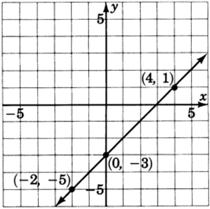
Looking carefully at this line, answer the following two questions.
At what number does this line cross the y-axis? Do you see this number in the equation?
The line crosses the y-axis at −3.
Place your pencil at any point on the line. Move your pencil exactly one unit horizontally to the right. Now, how many units straight up or down must you move your pencil to get back on the line? Do you see this number in the equation?
After moving horizontally one unit to the right, we must move exactly one vertical unit up. This number is the coefficient of
Graph the line
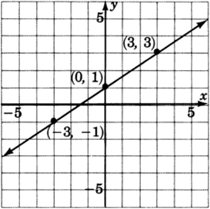
Looking carefully at this line, answer the following two questions.
At what number does this line cross the
The line crosses the
Place your pencil at any point on the line. Move your pencil exactly one unit horizontally to the right. Now, how many units straight up or down must you move your pencil to get back on the line? Do you see this number in the equation?
After moving horizontally one unit to the right, we must move exactly
Practice Set B
Graph the line
| - | - | |
| - | - | |
| - | - |
Looking carefully at this line, answer the following two questions.
At what number does the line cross the
- Answer
-
The line crosses the
Place your pencil at any point on the line. Move your pencil exactly one unit horizontally to the right. Now, how many units straight up or down must you move your pencil to get back on the line? Do you see this number in the equation?
- Answer
-
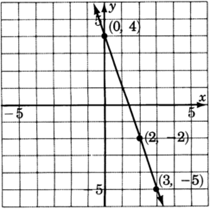
In the graphs constructed in Sample Set B and Practice Set B, each equation had the form

At what number does the line cross the
- Answer
-
In each case, the line crosses the
Place your pencil at any point on the line. Move your pencil exactly one unit horizontally to the right. Now, how many units straight up or down must you move your pencil to get back on the line? Do you see this number in the equation?
- Answer
-
To get back on the line, we must move our pencil exactly
Slope
The number
Since the equation
The slope-intercept form of a straight line is
The slope of the line is
The Slope is a Measure of the Steepness of a Line
The word slope is really quite appropriate. It gives us a measure of the steepness of the line. Consider two lines, one with slope
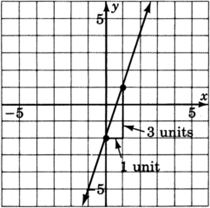
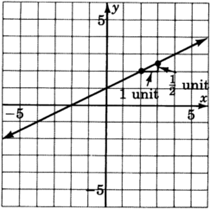
Sample Set C
Find the slope and the y-intercept of the following lines.
The line is in the slope-intercept form
Slope:
The line is in the slope-intercept form
Slope:
This equation is written in general form. We can put the equation in slope-intercept form by solving for
Now the equation is in slope-intercept form.
Slope:
Practice Set C
Find the slope and
- Answer
-
Solving for
The Formula for the Slope of a Line
We have observed that the slope is a measure of the steepness of a line. We wish to develop a formula for measuring this steepness.
It seems reasonable to develop a slope formula that produces the following results:
Steepness of line
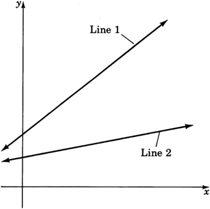
Consider a line on which we select any two points. We’ll denote these points with the ordered pairs
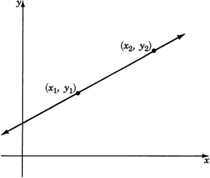
The difference in
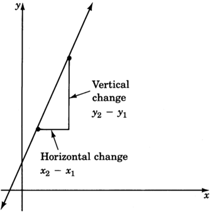
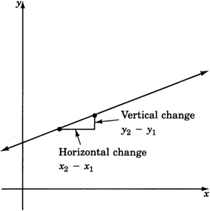
We are comparing changes. We see that we are comparing:
This is a comparison and is therefore a ratio. Ratios can be expressed as fractions. Thus, a measure of the steepness of a line can be expressed as a ratio.
The slope of a line is defined as the ratio
Mathematically, we can write these changes as
The slope of a nonvertical line passing through the points
Sample Set D
For the two given points, find the slope of the line that passes through them.
Looking left to right on the line we can choose
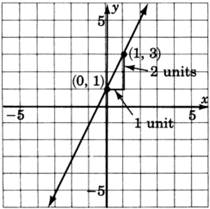
This line has slope
Notice that as we look left to right, the line rises.
Looking left to right on the line we can choose
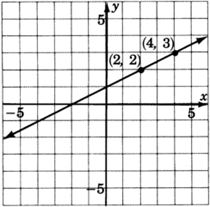
This line has slope
Notice that in examples 16 and 17, both lines have positive slopes,
Looking left to right on the line we can choose
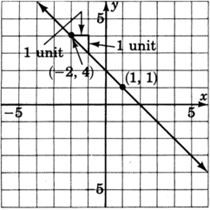
This line has slope
When the slope is written in fraction form,
Notice also that this line has a negative slope and declines as we look left to right.
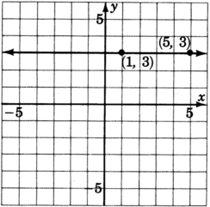
This line has
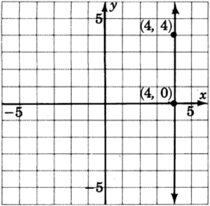
Since division by
Practice Set D
Find the slope of the line passing through
- Answer
-
Find the slope of the line passing through
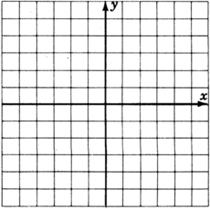
- Answer
-
The line has slope
Compare the lines of the following problems. Do the lines appear to cross? What is it called when lines do not meet (parallel or intersecting)? Compare their slopes. Make a statement about the condition of these lines and their slopes.
- Answer
-
The lines appear to be parallel. Parallel lines have the same slope, and lines that have the same slope are parallel

Before trying some problems, let’s summarize what we have observed.
- The equation
- The slope,
- The formula for finding the slope of a line through any two given points
- The fraction
- As we look at a graph from left to right, lines with positive slope rise and lines with negative slope decline.
- Parallel lines have the same slope.
- Horizontal lines have 0 slope.
- Vertical lines have undefined slope (or no slope).
Exercises
For the following problems, determine the slope and y-intercept of the lines.
- Answer
-
slope =
- Answer
-
slope =
- Answer
-
slope =
- Answer
-
slope =
- Answer
-
slope =
- Answer
-
slope =
- Answer
-
slope =
- Answer
-
slope =
- Answer
-
slope =
- Answer
-
slope =
- Answer
-
slope =
- Answer
-
slope =
- Answer
-
slope =
For the following problems, find the slope of the line through the pairs of points.
- Answer
-
- Answer
-
- Answer
-
- Answer
-
- Answer
-
- Answer
-
- Answer
-
- Answer
-
- Answer
-
Make a statement about the slopes of parallel lines.
- Answer
-
No slope (vertical line at
- Answer
-
Do lines with a positive slope rise or decline as we look left to right?
Do lines with a negative slope rise or decline as we look left to right?
- Answer
-
decline
For the following problems, determine the slope and y-intercept of the lines. Round to two decimal places.
- Answer
-
slope=
- Answer
-
slope=
For the following problems, find the slope of the line through the pairs of points. Round to two decimal places.
- Answer
-
- Answer
-
- Answer
-
No slope (vertical line
Exercises for Review
Simplify
- Answer
-
Solve the equation
When four times a number is divided by five, and that result is decreased by eight, the result is zero. What is the original number?
- Answer
-
Solve
Graph the linear equation
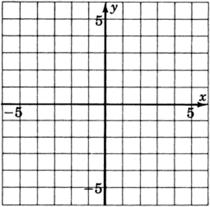
- Answer
-
